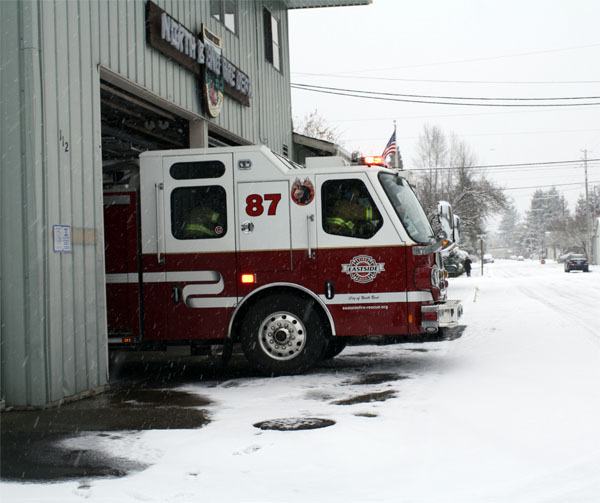North Bend’s fire station is no place to be in an emergency, maybe not even on a good day.
Located next to City Hall, the building has leaks, rats, a floor drain directly to the sewer system, loose windows, an overtaxed electrical system and almost no insulation or storage. It sits in a floodplain, and is so unstable that engineers estimate a third of it would collapse in another earthquake the size of the 2001 Nisqually quake.
“When this was built … it was never intended to be staffed full-time. This was a volunteer station,” explains firefighter Bob Butterfield on a tour of the station’s hazards and assorted repairs that firefighters have had to make do with.
The station badly needs fixing up, but the building is really old. The two sections were built in 1939 and 1970, so repairs like a new roof may outlast the building itself.
“You’re talking about an awful lot of repairs and an awful lot of money,” said North Bend Mayor Ken Hearing. “It becomes a question of efficiency.”
That question will be put to voters in February, as a $5.2 million bond issue to build a new fire station. The construction costs would be shared between the city of North Bend and Eastside Fire & Rescue District 38, which share the current facility, too. North Bend’s portion would be about $2.9 million.
The proposed levy rates for the new 20-year bond would be roughly 19 cents per $1,000 of assessed value for North Bend, and 17 cents per $1,000 of assessed value for property-owners in District 38, or roughly $75 per year for a $400,000 property.
If 60 percent of voters are in favor of the bond, work will begin on a new station about half a mile away, on North Bend Way. Plans for the proposed new station were presented in a public meeting Nov. 18. They included a lobby for the public, access for disabled people, and drive-through access for the emergency vehicles, all of which the current building lacks.
The new building would also be much more stable in an earthquake, as required by the Essential Public Facilities code. In the existing building, two vehicles are housed in the 1939-built section, under two massive roof beams “with gravity keeping them in place,” says Butterfield. Standing under one of the beams, he describes the plan for evacuating the building in an earthquake.
“We’ll pull out the engines on the other side first,” he says, then, barring any aftershocks, they’ll go back in for the other two. “But if we have to, we’re going to sacrifice the aid car and medic unit.”
The beams are far from the only health and safety issue in the building, however. The station is short one exhaust-extraction system, “so one vehicle is still contaminating the air in here,” says Butterfield. In the newer vehicle bays, there are always puddles on the floor, and the nearby floor drain occasionally backs up into the station flooding the floor with raw sewage. Towels and buckets hang from leaks in the ceiling and in several spots, the holes in the roof have been patched with plywood.
“This also shows our issue with maintaining a one-hour fire barrier,” EFR Fire Marshal Bud Backer points out. Fire stations must have a buffer between vehicle storage and personnel quarters that would keep a fire from spreading for one hour; plywood would only last a few minutes in a fire.
Upstairs in the living quarters, there are more roof leaks, you can push on the windows and see daylight between the frame and the building, and the rat problem is huge, despite the firefighters’ best efforts at trapping and eliminating them. Pictures of mice hang from various spots in the suspended ceiling throughout the living quarters, to indicate where the traps are.
“The population has been reduced, but we can’t eliminate them for some reason,” Backer said.
“A lot of them hang out in here. They’ll run right across the counters,” added station captain Mike Geppert.
Even with all the discomforts and challenges, though, Backer says, “To me, the seismic issues are paramount.”
City and fire officials agree the station must be replaced.
“We can’t afford to have the building fall down… We could put City Hall offices all over the city, but you’ve got to have your emergency services,” said Hearing.
“Right now, we’re trying to address the dire, dire needs,” added Fire Commissioner Chris Dahline.
Hearing and Dahline also agree that the current building will eventually be condemned, and City Hall relocated.
The proposed new station will not only meet the city’s and district’s current needs, but should be able to accommodate future growth and potential changes to the operating partnership between the city and Fire District 38.
“It’s actually meant to be flexible… to be built in such a way that it could house two different operations,” said North Bend City Administrator Duncan Wilson.
The next public meeting on the proposed new fire station will be in January, and the issue will go to voters in February.



